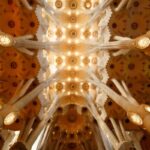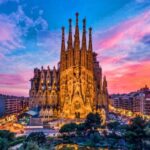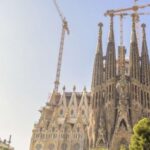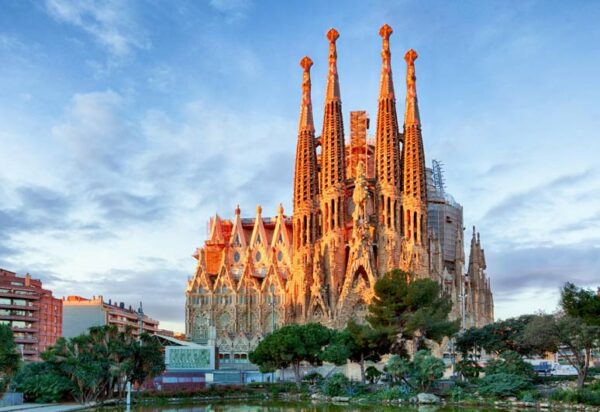
The Sagrada Familia, an iconic symbol of Barcelona, has captivated visitors for over a century with its intricate design and ambitious scale. Despite its fame, the ongoing construction raises questions about the prolonged timeline, intriguing both locals and tourists alike.
In this exploration, we delve into the complexities surrounding this architectural marvel. **The Mystery Unveiled: Discovering Why the Sagrada Familia in Barcelona Takes So Long** reveals not only the challenges faced by architects and builders but also the vision that drives this monumental project forward.
The Architectural Challenges Behind the Sagrada Familia's Construction
The construction of the Sagrada Familia presents a series of architectural challenges that stem from its unique design and the innovative techniques employed by Antoni Gaudí. One of the most significant hurdles is the complex geometric shapes that define the basilica. These shapes require precise calculations and advanced engineering methods to ensure stability and aesthetic appeal.
Moreover, the use of natural forms inspired by nature presents additional difficulties. Gaudí's vision included organic structures that mimic trees and other elements of the natural world. This approach demands a careful balance between artistic expression and structural integrity, often complicating the construction process.
- Materials Selection: The choice of materials must complement Gaudí's design while offering durability and support.
- Workforce Training: Skilled artisans are needed to execute the intricate details that characterize the Sagrada Familia.
- Technological Advances: The integration of modern technology has allowed for more efficient construction methods but also presents the challenge of adapting historical designs to contemporary practices.
In addition, the regulatory environment surrounding the construction has evolved over time, introducing new standards and requirements that must be met. This not only affects the timeline but also the overall cost and approach to the project. Ultimately, the combination of these factors contributes to the prolonged construction period of this extraordinary architectural masterpiece.
Understanding the Historical Significance of the Sagrada Familia
The Sagrada Familia's historical significance extends beyond its stunning architecture; it embodies a profound cultural narrative that reflects Barcelona's identity. Designed by Antoni Gaudí, this basilica is not just a religious site but a symbol of innovation and creativity, intricately woven into the fabric of the city since its inception in 1882. Its construction has witnessed numerous historical events, making it a living testament to Barcelona's evolution over the decades.
Moreover, the Sagrada Familia represents a fusion of religious dedication and artistic ambition. Gaudí envisioned a structure that would be a tribute to the Christian faith, aiming to convey biblical stories through its design and sculptures. This aspect of the basilica provides visitors with not only an architectural marvel but also a spiritual journey, reinforcing its importance as a place of pilgrimage and reflection.
Key historical milestones highlight the Sagrada Familia's journey, including:
- 1882: Construction begins under architect Francisco de Paula del Villar.
- 1883: Antoni Gaudí takes over the project, radically transforming its design.
- 1936: The Spanish Civil War halts construction, resulting in significant damage to Gaudí’s original plans.
- 2026: The projected completion date, coinciding with the 100th anniversary of Gaudí's death.
As the Sagrada Familia nears its long-awaited completion, it embodies a blend of historical perseverance and visionary architecture. The ongoing construction serves as a reminder of Gaudí's legacy and the cultural significance of this extraordinary site, drawing millions of visitors each year who seek to understand its story and appreciate its beauty.
The Role of Antoni Gaudí in the Sagrada Familia's Design
Antoni Gaudí's influence on the Sagrada Familia's design is profound and multifaceted. His unique vision transformed a standard basilica into a breathtaking masterpiece that reflects his deep understanding of architecture and nature. Gaudí's approach centered around organic forms, which allowed him to create a structure that resonates with both spiritual and natural elements, emphasizing harmony and unity.
One of the most remarkable aspects of Gaudí's work is his innovative use of geometry. He employed a variety of shapes and structures, such as hyperboloids and helicoids, to ensure both aesthetic beauty and structural integrity. This pioneering approach can be summarized in the following ways:
- Natural Inspirations: Gaudí drew from nature, incorporating shapes that resemble tree branches and caves.
- Symbolic Elements: Each part of the Sagrada Familia is rich with symbolism, representing biblical stories and spiritual concepts.
- Structural Innovation: Gaudí utilized catenary arches and other natural forms to enhance stability.
Moreover, Gaudí's dedication to the project was unwavering, as he famously stated that his client was not in a hurry—an acknowledgment of the divine aspect of his work. This philosophy has led to a construction process that is as much about artistry as it is about engineering, making the Sagrada Familia a living testament to his legacy. His meticulous attention to detail and unwavering commitment to his vision continue to inspire both architects and visitors alike.
Today, Gaudí's original plans serve as a guiding light for the ongoing construction. His sketches and models, although damaged during the Spanish Civil War, have been crucial in preserving his artistic intent. The collaboration between modern architects and craftsmen ensures that Gaudí's dream becomes a reality, allowing future generations to appreciate the magnificence of the Sagrada Familia.
Unraveling the Delays: Factors Influencing the Construction Timeline
Unraveling the delays in the construction of the Sagrada Familia involves examining several critical factors that influence its timeline. One major aspect is the funding sources, which primarily rely on donations and ticket sales. This model can lead to fluctuations in available resources, affecting the pace of construction and resulting in intermittent work periods.
Additionally, the complexity of the design adds to the lengthy timeline. Gaudí's intricate and ambitious vision requires skilled craftsmanship that cannot be rushed. The use of traditional methods alongside modern technology creates a unique synergy, but it also necessitates careful coordination and planning. As a result, the construction schedule often adapts to the availability of specialized artisans and materials.
- Historical Preservation: Efforts to maintain the integrity of Gaudí's original vision often result in longer construction times, as new techniques must be developed to respect the past.
- Changing Regulations: Compliance with evolving building codes and regulations can halt or slow progress, as adjustments must be made to meet contemporary standards.
- Visitor Impact: The high volume of tourists also influences construction schedules, as work must be carefully managed around visitor access to the site.
These factors, coupled with the enduring commitment to create a masterpiece that honors Gaudí's legacy, contribute significantly to the Sagrada Familia's prolonged construction timeline. Ultimately, each delay is a testament to the dedication of all those involved in bringing this architectural wonder to life.
Exploring the Funding and Resources for the Sagrada Familia Project
The funding and resources for the Sagrada Familia project are as complex as its architectural design. Primarily financed through private donations and the revenue generated from ticket sales, the project relies heavily on the generosity of visitors and locals alike. This unique funding model means that construction progress can fluctuate significantly, depending on the financial contributions received at any given time.
In addition to donations, the basilica has also received support from various organizations and government grants, aimed at preserving Gaudí's legacy. These funds are crucial in covering the ongoing costs of skilled labor and quality materials, which are essential for maintaining the project's ambitious standards. The need for high-quality craftsmanship ensures that each phase of construction respects Gaudí’s original vision, further complicating the financial landscape.
- Visitor Contributions: The continuous influx of tourists is vital, as ticket sales directly fund construction efforts.
- Artisan Costs: Skilled artisans are necessary for intricate details, and their wages represent a significant portion of the overall budget.
- Material Expenses: Sourcing traditional materials that align with Gaudí's design adds another financial layer, ensuring both authenticity and durability.
Despite the challenges posed by its funding model, the Sagrada Familia continues to thrive due to the ongoing commitment of its supporters. The project serves as a testament to the community's dedication to preserving this architectural wonder for future generations, ensuring that every donation, big or small, plays a crucial role in bringing Gaudí's dream to fruition.
The Cultural Impact of the Sagrada Familia on Barcelona's Identity
The Sagrada Familia is more than just an architectural masterpiece; it has become a cultural emblem of Barcelona, influencing the city's identity in profound ways. Its unique design and spiritual significance attract millions of visitors each year, making it a central fixture in the cultural landscape of the city. This iconic basilica embodies the fusion of art, faith, and history, reflecting the spirit of Barcelona itself.
Local residents take pride in the Sagrada Familia, viewing it as a symbol of community resilience and creativity. The ongoing construction process has fostered a sense of unity among those who wish to see Gaudí's vision realized. The basilica's presence in the cityscape serves as a daily reminder of the artistic heritage that defines Barcelona, inspiring local artists and architects to push the boundaries of their own work.
- Tourism Impact: The Sagrada Familia is one of the most visited monuments in the world, significantly contributing to the local economy.
- Cultural Events: The site hosts various cultural events and activities, promoting Barcelona's vibrant arts scene.
- Educational Programs: Schools and institutions often incorporate visits to the basilica into their curricula, enhancing cultural awareness among younger generations.
Ultimately, the Sagrada Familia stands as a living testament to Barcelona's dynamic identity, combining history, faith, and artistic innovation. As construction progresses toward its anticipated completion, the basilica will continue to shape the city's cultural narrative, ensuring that Gaudí's legacy endures for future generations to appreciate.
 Explore the Astonishing Interior of Barcelona's Sagrada Familia Church
Explore the Astonishing Interior of Barcelona's Sagrada Familia Church Sagrada Familia in Barcelona: Your Ultimate Guide to this Architectural Wonder
Sagrada Familia in Barcelona: Your Ultimate Guide to this Architectural Wonder Experience the Marvel of Sagrada Familia with Barcelona Tickets
Experience the Marvel of Sagrada Familia with Barcelona TicketsIf you want to know other articles similar to The Mystery Unveiled: Discovering Why the Sagrada Familia in Barcelona Takes So Long you can visit the category WHERE YOU CAN GO.
Leave a Reply










Read more!